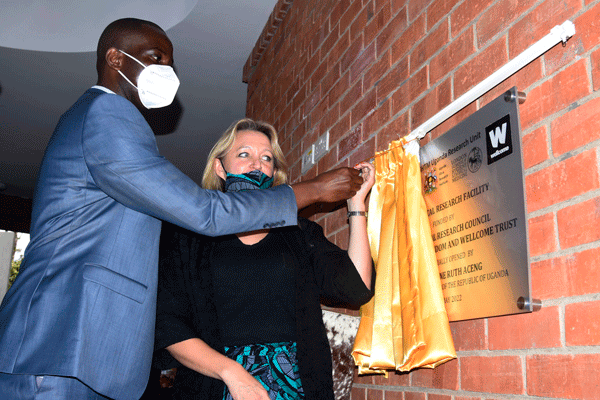Prime
Govt to test genetically modified mosquitoes

British High Commissioner to Uganda Kate Airey (right) and an Under Secretary at the Health ministry, Mr Kenneth Akire, commission the clinical research facility at UVRI in Entebbe yesterday. PHOTO / ISAAC KASAMANI
What you need to know:
- Mr Fabrice Rulinda, the Entebbe mayor, said yesterday at the commissioning of the clinical research facility at UVRI that he accepted the plans because he sees good benefits.
The Uganda Virus Research Institute (UVRI) has approached the Entebbe Municipality leadership regarding plans to release genetically modified mosquitoes (GMMs) for experimental purposes in a move to fight malaria.
Mr Fabrice Rulinda, the Entebbe mayor, said yesterday at the commissioning of the clinical research facility at UVRI that he accepted the plans because he sees good benefits.
“Last time, these people from the Institute approached me and they said they are bringing new mosquitoes to the community. I was surprised. I told them we already have enough [mosquitoes] but they told me these are biologically modified and they will give birth to only male mosquitoes. I told them it is interesting. I did agree to you (UVRI) putting more mosquitoes into the community, I am still waiting…,” he said.
Prof Pontiano Kaleebu, the UVRI director, told Daily Monitor that they have not yet released the GMMs. “No mosquitoes have been released. They are in a containment facility, an insectary. We are now preparing to work on a modified mosquito. It has not yet started but we have put in mechanism how we can contain,” he said.
The GMMs, according to scientists, do not transmit malaria parasites when they bite.
Dr Jonathan Kayondo, the project lead at the UVRI, told Daily Monitor earlier that when the modified male mosquito mates with common mosquitoes, the female offsprings are infertile.
This, he explained, will significantly suppress the population or eliminate mosquitoes thereby stopping malaria transmission and deaths.
“We have malaria control measures such as insecticide-treated mosquito nets, indoor residual spraying and drugs for the treatment of malaria, which have helped a lot, but malaria is still here with us. We need to get additional tools to help us eradicate the disease,” Dr Kayondo said yesterday at the UVRI headquarters in Entebbe.
Malaria kills 16 Ugandans daily and causes an estimated annual economic loss of $500 million (Shs1.76 trillion) due to treatment costs and work time lost, according to government statistics.
The National Environment Management Authority (Nema) said they received the application from the UVRI about the plan to develop and release a new species, but it was not clear whether it was approved.
“Any tool that can sustain the intervention against malaria is important. The project came to us because we are regulating. We consulted other stakeholders to understand the risk aspect of the experiment...Any project which is implemented with the population aware of it and are expecting results will succeed,” the agency said.
The GMMs which Nature.com reported last year in May that were released in the United Kingdom by Biotech firm Oxitec for experimental purposes, have attracted strong criticism from conservationists the world over.
Dr Edward Nector Mwavu, an ecologist at Makerere University College of Agriculture and Environment Sciences, told this reporter the foreign genes inserted in the mosquitoes could affect organisms that will feed on the GMMs and man in the long run.
“In science, we talk about the precautionary principle. If you don’t know much about something, you shouldn’t tamper with it. The concern is that we don’t know how these modified genes will react in the organisms that feed on mosquitoes. The genes may cause problems or even change the genetic codes of the organisms that feed on them. We have heard about Covid-19 which is a result of mutation,” he said.
How GMMS work
1. Normal mosquitoes (NM) are collected and reared in a laboratory
2. Female NM lay eggs
3. A foreign gene is inserted into each egg of NM in the laboratory
4. The egg will hatch into a genetically modified mosquito (GMM)
5. GMM male mosquito is selected and released into the environment to mate with NM
6. Offspring of GMM and NM are infertile




